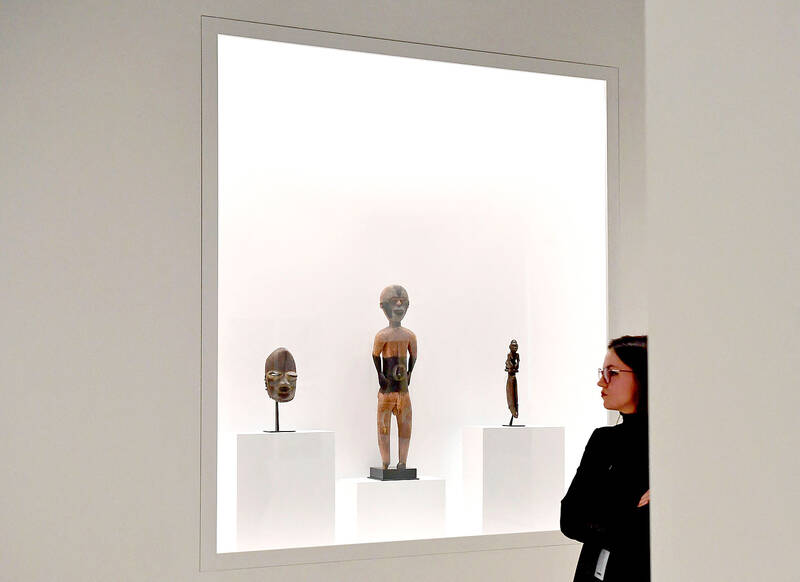The Picasso Museum in Malaga, the southern Spanish city where the artist was born, will opened a new exhibition yesterday which groups his works according to theme instead of by period.
The show — which runs until March 2027 — brings together 141 Pablo Picasso works that the artist kept for himself, including 10 which were never before seen in Spain.
“We have not followed chronology strictly. We do begin with the very early work of Picasso and we end with the last work that he created but within that we often are combining works from different decades,” said the curator of the exhibition, Michael FitzGerald, a professor of art history at Trinity College in the US.

Photo: AFP
“It is a group of works, paintings, sculptures, drawings, prints that represents the entire production of Picasso I hope very accurately. and we particularly emphasised ceramics among them which is a part of Picasso’s work that is often not shown and not perhaps taken as seriously as it should.”
Museums have traditionally displayed works by Picasso grouped according to his key periods, from blue, pink and cubist to surrealist.
Picasso’s great-grandson, Bernard Ruiz-Picasso, said combining works of distinct periods and techniques “allow us to link different moments of his life”.

Photo: AFP
Among the works never exhibited before in Spain is a 1922 painting called “Paul” which depicts the artist’s son as well as the 1933 sculpture Femme accoudeed (1933) and a dish decorated with a bull’s head from the 1950s.
Opened in 2003 in a 16th century mansion, Malaga’s Picasso Museum is located just a couple of hundred meters from the house where the artist was born in 1881.
Picasso left for Paris in 1904 and most of his adult years were spent in France where he died in 1973. The Picasso Museum in the French capital houses the world’s biggest collection of the artist’s works.

That US assistance was a model for Taiwan’s spectacular development success was early recognized by policymakers and analysts. In a report to the US Congress for the fiscal year 1962, former President John F. Kennedy noted Taiwan’s “rapid economic growth,” was “producing a substantial net gain in living.” Kennedy had a stake in Taiwan’s achievements and the US’ official development assistance (ODA) in general: In September 1961, his entreaty to make the 1960s a “decade of development,” and an accompanying proposal for dedicated legislation to this end, had been formalized by congressional passage of the Foreign Assistance Act. Two

March 31 to April 6 On May 13, 1950, National Taiwan University Hospital otolaryngologist Su You-peng (蘇友鵬) was summoned to the director’s office. He thought someone had complained about him practicing the violin at night, but when he entered the room, he knew something was terribly wrong. He saw several burly men who appeared to be government secret agents, and three other resident doctors: internist Hsu Chiang (許強), dermatologist Hu Pao-chen (胡寶珍) and ophthalmologist Hu Hsin-lin (胡鑫麟). They were handcuffed, herded onto two jeeps and taken to the Secrecy Bureau (保密局) for questioning. Su was still in his doctor’s robes at

Last week the Democratic Progressive Party (DPP) said that the budget cuts voted for by the China-aligned parties in the legislature, are intended to force the DPP to hike electricity rates. The public would then blame it for the rate hike. It’s fairly clear that the first part of that is correct. Slashing the budget of state-run Taiwan Power Co (Taipower, 台電) is a move intended to cause discontent with the DPP when electricity rates go up. Taipower’s debt, NT$422.9 billion (US$12.78 billion), is one of the numerous permanent crises created by the nation’s construction-industrial state and the developmentalist mentality it

Experts say that the devastating earthquake in Myanmar on Friday was likely the strongest to hit the country in decades, with disaster modeling suggesting thousands could be dead. Automatic assessments from the US Geological Survey (USGS) said the shallow 7.7-magnitude quake northwest of the central Myanmar city of Sagaing triggered a red alert for shaking-related fatalities and economic losses. “High casualties and extensive damage are probable and the disaster is likely widespread,” it said, locating the epicentre near the central Myanmar city of Mandalay, home to more than a million people. Myanmar’s ruling junta said on Saturday morning that the number killed had